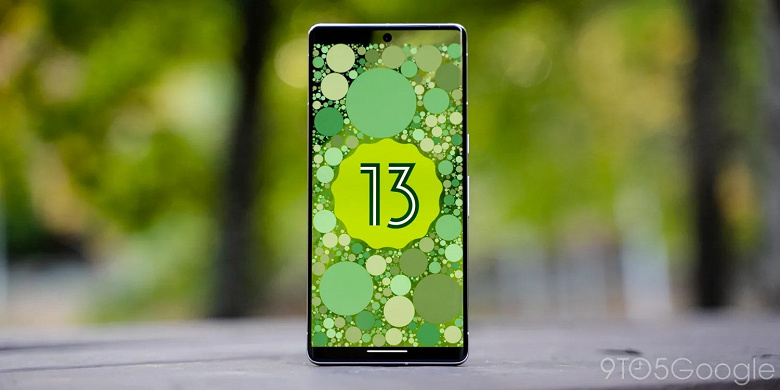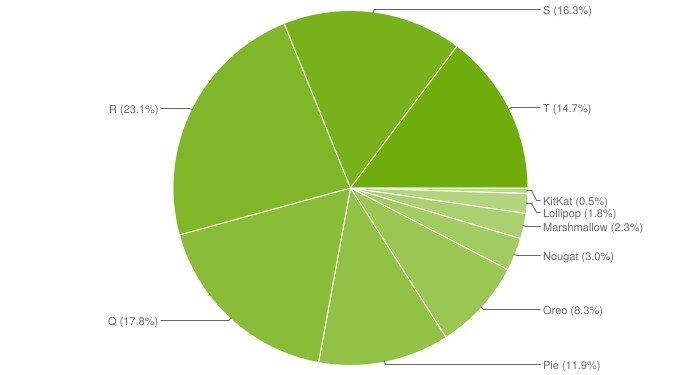Last updated on March 27th, 2024 at 11:28 am
Android 13 takes only 14.7%
Google, following Apple, published statistics on the prevalence of a particular version of Android.

The most common version is Android 11. This system is installed on 23.1% of all active devices. This is followed by an even older Android 10 with 17.8%, but Android 12 is breathing down its back with 16.3%.
Android 10 is still much more popular than Android 13.

The current Android 13 is only on the fourth line with a share of 14.7%. You can also highlight Android 9, which holds 11.9% of the market. All other versions have less than 10%.
difference between android 10 and 13
- Privacy: Android 10 has some privacy features, like the ability to deny permissions to apps. Android 13 has more comprehensive privacy controls.
- Performance: Android 13 has performance improvements, like faster app launches and smoother scrolling.
- Interface: Android 13 has a redesigned interface, including a prettier volume slider.
- Features Android 13 has new features and design tweaks, including:
- Auto-theming icons
- More Material You theming options
- Alternative lock screen clock setup
- Updated Now Playing widget
- More intuitive QR scanner support
- Native Bluetooth LE Audio support
- Predictive back gesture for Android devices
- Support for the new MIDI 2.0 standard
- Media output: Android 13 has an updated media output switcher.
- Bluetooth: Android 13 is the first version of Android to introduce support for Bluetooth Low-Energy Audio. This standard is meant as a replacement or alternative for regular Bluetooth audio streaming.
android 10 vs android 13
Android 10 and Android 13 are both major versions of the Android operating system, but there are a number of key differences between the two. Here is a comparison of some of the most notable features:
- Privacy and security: Android 13 introduces a number of new privacy and security features, including:
- The ability to give apps one-time permissions to access your location, camera, or microphone.
- The ability to see which apps are using your microphone or camera in the background.
- The ability to require apps to ask for your permission to send you notifications.
- The ability to create a privacy-focused profile for your work or school accounts.
- Personalization: Android 13 also includes a number of new personalization features, including:
- The ability to set a different accent color for each app.
- The ability to choose different notification sounds for different apps.
- The ability to create custom widgets.
- The ability to use a picture-in-picture mode for videos.
- Performance: Android 13 also includes a number of performance improvements, including:
- Faster app launches.
- Smoother scrolling.
- Better battery life.
Overall, Android 13 is a significant update over Android 10. It offers a number of new features and improvements that make it a more secure, personalized, and performant operating system.
Here is a table summarizing the key differences between Android 10 and Android 13:
| Feature | Android 10 | Android 13 |
|---|---|---|
| Privacy and security | Basic privacy features | More granular privacy controls |
| Personalization | Limited options | More customization options |
| Performance | Good performance | Improved performance |
If you are looking for a more secure, personalized, and performant Android experience, then Android 13 is the better choice. However, if you are happy with your current Android experience, then you may not need to upgrade to Android 13.
Android 13 vs Android 10
Android 13 and Android 10 are both major versions of the Android operating system, but there are some key differences between the two.
Here is a comparison of the two versions:
| Feature | Android 13 | Android 10 |
|---|---|---|
| Material You theming | Android 13 builds on the Material You theming introduced in Android 12, with more customization options for users to choose from. | Android 10 does not have Material You theming. |
| Per-app language support | Android 13 allows users to set a different language for each app. This is useful for people who speak multiple languages or who want to use an app in a different language than their device’s default language. | Android 10 does not have per-app language support. |
| Privacy features | Android 13 has a number of new privacy features, such as the ability to revoke permissions for apps that are not in use, and the ability to see which apps have accessed your microphone or camera in the past 24 hours. | Android 10 has some privacy features, such as the ability to deny permissions to apps, but Android 13 has more comprehensive privacy controls. |
| Performance improvements | Android 13 has performance improvements, such as faster app launches and smoother scrolling. | Android 10 also has performance improvements, but Android 13 has more noticeable improvements. |
Overall, Android 13 is a more polished and feature-rich version of Android than Android 10. If you are looking for the latest and greatest features, then Android 13 is the better choice. However, if you are happy with your current phone and operating system, then there is no need to upgrade to Android 13.
Here are some additional features of Android 13:
- New media player UI
- Improved notification management
- New keyboard shortcuts
- Support for foldable and rollable devices
- Better security and privacy features
If you are interested in learning more about Android 13, you can visit the official Android website.
Android 10 vs Android 13
Android 10 and Android 13 are the tenth and thirteenth major releases of the Android operating system, respectively. Android 10 was released in September 2019, while Android 13 was released in August 2022.
Here is a comparison of some of the key features of Android 10 and Android 13:
| Feature | Android 10 | Android 13 |
|---|---|---|
| System navigation | Gestures or 3-button navigation | Gestures only |
| Dark mode | System-wide dark theme | System-wide dark theme with more customization options |
| Privacy | More granular control over location data | More privacy permissions controls, including the ability to grant apps permission to access your location only when you are using them |
| Digital wellbeing | Focus Mode, Wind Down | Focus Mode, Wind Down, and new features such as Bedtime Mode and Digital Wellbeing for Kids |
| Other features | Live Caption, Smart Reply | Live Caption, Smart Reply, and new features such as App Search, Nearby Share, and Wi-Fi password sharing |
In addition to the above features, Android 13 also includes a number of other improvements, such as:
- A new interface design for tablets and foldable phones
- A more capable split-screen mode for multitasking
- A ChromeOS-like desktop-style taskbar
- More customization options for Material You
- Improved performance and stability
Overall, Android 13 is a more polished and feature-rich operating system than Android 10. However, Android 10 is still a very good operating system, and it is still supported by most Android devices.
Which version of Android should you choose?
If you have a choice between Android 10 and Android 13, I recommend choosing Android 13. It is a more modern and feature-rich operating system. However, if you are already using an Android device with Android 10 and you are happy with it, there is no need to upgrade to Android 13.




